From October 6–7, community health center (CHC) leaders from across the country converged in Denver for the first-ever Advocates for Community Health (ACH) Best Practices Showcase. Under the theme, “Innovations in Health Care Access,” the event highlighted one central truth: CHCs are not waiting for change—they are building it from the ground up.
What began as a membership-driven idea became a vibrant forum for sharing real-world solutions, learning from peers, and charting next steps for community health centers.
Eleven CHCs presented forward-looking models spanning reimagined care delivery, patient engagement, workforce development, data-driven quality improvement, and senior care programs. These weren’t theoretical pilots; they were functioning, cost-effective initiatives already improving lives. Each demonstration showed how targeted investment, operational flexibility, and thoughtful policy design translate directly into better outcomes for patients and communities.
Key Takeaways for Policymakers:
- Flexibility fuels innovation. When CHCs have the ability to test and adapt new care models, including through grant funding or payer partnerships, they uncover scalable solutions that improve efficiency and patient outcomes.
- Workforce investment pays dividends. From pipeline programs to nurse-led initiatives and AI solutions, sustainable staffing policies ensure continuity of care in communities.
- Data and accountability go hand in hand. Analytics tools and performance dashboards help guide smarter resource allocation.
- Policy alignment accelerates success. Federal and state policies that support the CHC model of whole person care enable these local breakthroughs to spread.
Stories That Bring Policy to Life
1. Mountain Comprehensive Health Center: R.A.I.S.E Workforce Development Program
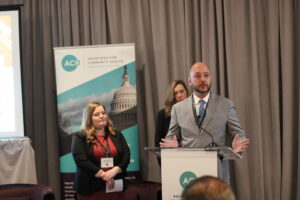 R.A.I.S.E. (Reach, Achieve, Inspire, Support, Employ) addresses severe staffing shortages in rural Kentucky by recruiting and training locally through partnerships with colleges and universities. Policymakers can support programs like R.A.I.S.E. to sustain rural CHCs and expand access.
R.A.I.S.E. (Reach, Achieve, Inspire, Support, Employ) addresses severe staffing shortages in rural Kentucky by recruiting and training locally through partnerships with colleges and universities. Policymakers can support programs like R.A.I.S.E. to sustain rural CHCs and expand access.
2. Morris Heights Health Center (MHHC): Reimagining Community Health
 MHHC’s BeWell model integrates preventive, primary, and chronic care to close gaps in the Bronx, NY. Policymakers can support integrated care and whole-patient approaches to improve community health outcomes.
MHHC’s BeWell model integrates preventive, primary, and chronic care to close gaps in the Bronx, NY. Policymakers can support integrated care and whole-patient approaches to improve community health outcomes.
3. Lone Star Circle of Care (LSCC) and Sun River Health: Artificial Intelligence (AI) and the Future of Patient Care
 LSCC in Texas and Sun River Health in New York demonstrated AI and robotic process automation to streamline medical coding, reduce claim backlogs, and improve revenue cycle efficiency, freeing staff to focus on patient care. Policymakers can support AI adoption with regulatory flexibility, privacy safeguards, and funding for technology integration.
LSCC in Texas and Sun River Health in New York demonstrated AI and robotic process automation to streamline medical coding, reduce claim backlogs, and improve revenue cycle efficiency, freeing staff to focus on patient care. Policymakers can support AI adoption with regulatory flexibility, privacy safeguards, and funding for technology integration.
4. HealthSource of Ohio: Strengthening Patient Engagement to Reduce Costs
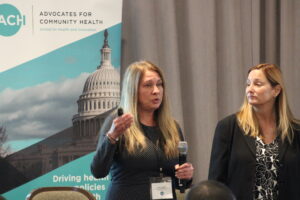 A pilot program focused on attribution, access, and outreach connects patients who have not engaged in care, reducing costs and improving outcomes. Policymakers can support such programs through funding, care coordination incentives, and data-driven outreach initiatives.
A pilot program focused on attribution, access, and outreach connects patients who have not engaged in care, reducing costs and improving outcomes. Policymakers can support such programs through funding, care coordination incentives, and data-driven outreach initiatives.
5. Swope Health: Mission-Driven Acquisitions and a Playbook to Preserve Access
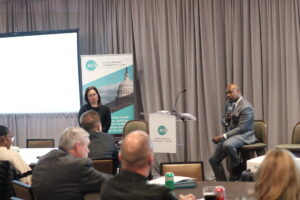 This session explored the pressing question: What happens when primary care practices close, and how can community health centers respond? Through an interactive Q&A, strategies for leveraging partnerships and acquisitions to sustain access to care, minimize disruption for patients, and strengthen the broader community health ecosystem were discussed. Policymakers can support such efforts by fostering regulatory flexibility, incentivizing collaborative solutions, and providing funding mechanisms that help CHCs ensure continuity of care during closures.
This session explored the pressing question: What happens when primary care practices close, and how can community health centers respond? Through an interactive Q&A, strategies for leveraging partnerships and acquisitions to sustain access to care, minimize disruption for patients, and strengthen the broader community health ecosystem were discussed. Policymakers can support such efforts by fostering regulatory flexibility, incentivizing collaborative solutions, and providing funding mechanisms that help CHCs ensure continuity of care during closures.
6. Sun River Health: Using Nurses to Address Population Health Objectives
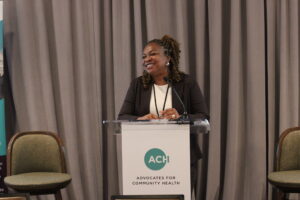 Sun River Health’s nurse-driven transition-of-care model and Sun River Spotfire data hub improve coordination, outcomes, and reduce costs. Policymakers can support replication by encouraging nurse-led care models, funding integrated data systems, and promoting workforce strategies that optimize population health management.
Sun River Health’s nurse-driven transition-of-care model and Sun River Spotfire data hub improve coordination, outcomes, and reduce costs. Policymakers can support replication by encouraging nurse-led care models, funding integrated data systems, and promoting workforce strategies that optimize population health management.
7. San Ysidro Health and Jordan Valley Community Health Center: Innovations in Senior Care
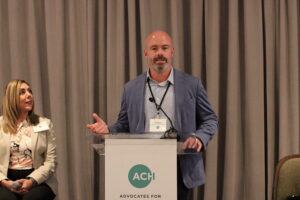 Two health centers with one common goal – advancing senior care through PACE (Program of All-Inclusive Care for the Elderly). Drawing on a decade of experience, San Ysidro Health inspired Jordan Valley CHC’s first-year PACE implementation. The session demonstrated how CHCs can expand services to meet the needs of aging populations. Policymakers can support these efforts by enabling funding, reimbursement, and regulatory frameworks that sustain and scale senior-focused programs.
Two health centers with one common goal – advancing senior care through PACE (Program of All-Inclusive Care for the Elderly). Drawing on a decade of experience, San Ysidro Health inspired Jordan Valley CHC’s first-year PACE implementation. The session demonstrated how CHCs can expand services to meet the needs of aging populations. Policymakers can support these efforts by enabling funding, reimbursement, and regulatory frameworks that sustain and scale senior-focused programs.
In addition, Evara Health in Florida presented during the meeting on how launching infusion services in underserved communities requires strategic alignment, and Peninsula Community Health Services in Washington demonstrated how in-house lawyers help CHCs navigate compliance, guide innovation, and support strategic growth at a fraction of the cost of outside firms.
All of the presentations underscored a shared truth: when policy and practice align, innovation thrives — and so do communities.
Why This Matters for Decision-Makers
Community health centers serve nearly 34 million Americans, 90% of whom are under 200% of the Federal Poverty Level. Yet these same centers operate under tight financial constraints, often with just 1-2% margins, and rigid rules that can stifle experimentation.
The Showcase made clear that modest policy changes can yield an outsized impact. Some key takeaways:
- Stable funding cycles allow long-term planning and innovation.
- Modernized reimbursement models reward outcomes, not volume.
- For policymakers seeking data-driven, bipartisan strategies to strengthen the healthcare system, CHCs offer a blueprint that is both practical and proven.
A Call to Action
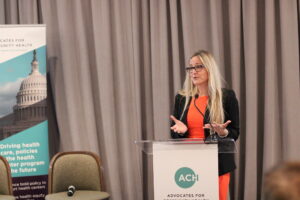 ACH’s CEO, Amanda Pears Kelly, reminded attendees that innovation isn’t limited to technology — it’s about trust, creativity, and community.
ACH’s CEO, Amanda Pears Kelly, reminded attendees that innovation isn’t limited to technology — it’s about trust, creativity, and community.
“When CHCs have the resources and flexibility to innovate and share their best ideas, everyone rises.”
Policymakers have a critical opportunity to invest in the nation’s community health centers. By providing stable, predictable funding and aligning financial incentives with on-the-ground realities, Congress and state leaders can empower CHCs to expand access, sustain high-quality care, and continue delivering efficient, community-based solutions that work.
The message is urgent: innovation is happening in America’s CHCs, and robust, reliable funding is what will allow it to thrive.